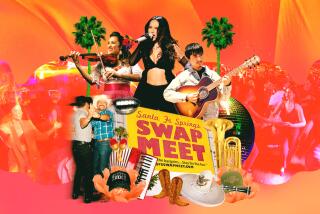The rhythms of a universe
“This is a history of music from a Cuban point of view,” Ned Sublette explains right off in “Cuba and Its Music,” sounding a little nervous about his unconventional project. Sublette’s statement is not exactly true. His subject isn’t music, it’s Cuban music, although if you were to get him drunk he might tell you that in the 20th century the two concepts were nearly identical. Nor is the music described from a Cuban point of view, and that’s not because Sublette is a New York-based Texan.
The vantage is Afro-Cuban -- this book is one of the few general music histories to give African usages, values and materials more weight than European ones. As Sublette notes, even Alejo Carpentier, the Paris-educated Europhile whose 1946 “La musica en Cuba” insisted prophetically on granting black Cubans something approaching musical parity, reserves a separate chapter for the African-tinged music of white avant-gardists Amadeo Roldan and Alejandro Garcia Caturla, while barely discussing 20th century Cuban popular music. Similarly, in Helio Orovio’s “Cuban Music From A to Z,” recommended by Sublette as “a basic reference tool,” Roldan and Caturla get four or five times as many lines as band-leading songwriter-virtuoso Arsenio Rodriguez and seminal bassist Israel “Cachao” Lopez.
That’s not how Sublette parcels out the kudos. A schooled musician, he gives Roldan and Caturla their remarkable-to-heroic due. (Caturla, also a corruption-fighting judge, was assassinated.) But he leaves little doubt that Cachao, “arguably the most important bassist in twentieth-century popular music,” stands as a more original and momentous artist. And Rodriguez, the blind grandson of a Congo-born slave, is the wellspring. As a leader he invented the modern trumpet-conga-cowbell conjunto; as a player he established the guitar-like tres as a decisive influence on the rhythmic ostinatos that now anchor Latin music; as a lyricist he articulated the Cuban version of Pan-Africanism. Also, he writes, “Arsenio played a decisive role in the new clave consciousness.” “Clave” is Spanish for key, and claves are the hardwood ship pegs with which Havana musicians beat out Latin music’s characteristic three-and-two rhythm (familiar to Yankees in the form of the African American “soul clap”). In Sublette’s conception, clave is a “rhythmic key,” and Rodriguez, steeped in African retentions and Matanzas rumba, is a fundamental genius.
Not that Sublette subscribes to what kindred spirit Robert Palmer dismissed as great-man theories of African-based music. This is not merely a history of musicians, or even of music. Assuming correctly that few English speakers knew anything about Cuba before, say, 1952, which happens to be when this fascinating 600-page first volume ends, Sublette also hones in on straight history: Cuba’s early prominence as a Caribbean nexus, its conversion to a sugar economy, its relatively late and extremely brutal dependence on the slave trade, its troubled relationship with its royalist proprietors in Spain and its democratic exploiters in the U.S.
And Sublette doesn’t start there. Before he even gets to Cuba, he has devoted 60 pages to a prehistory that may be the most remarkable about it. For if Cuban music is to prove as crucial as he believes, there had better be more to its Spanish heritage than is generally understood by musicologists such as “Music in Western Civilization’s” Paul Henry Lang, who called Spain “indescribable.” So Sublette limns an untold pre-Columbian history in which Spain, with helpful input from Muslim invaders, is a more cultured and happening place than Rome, France, Britain or Germany. Though he concentrates on Spain’s Moorish phase, detailing competing strains of Islam and the different Africans who participated in the faith’s bitter and myriad sectarian disputes, he goes all the way back to 1st century Cadiz, described fancifully but plausibly as a seafaring hot spot whose night life was already “informed by centuries of direct and indirect contact with black Africa.”
His story moves through Cordoba, where, in the 9th century, Baghdad-born “Black Songbird” Ziryab had the lineaments of a rock star, then to the “cosmopolitan boomtown” of Seville, a center of the slave and gold trades from which spread the 16th century craze for the saraband, a dance Sublette traces linguistically. Seville was rife with guitars and drums, the latter barely known in the rest of Europe. Havana, he tells us, was the New World Seville.
Even before sugar fully Africanized Cuba, music was a black trade in Havana, where the substantial free population had limited career options. Havana was one of the largest cities in the Western hemisphere, surpassed by New York only in 1810, and in the 1840s boasted one of America’s two resident Italian opera companies, owned by a major slave trader. Havana’s black musicians mastered European forms and instruments but found audiences for their more rhythmic music in bars and brothels and within the four distinct Afro Cuban religions Sublette lays out. (Santeria being the polite one.) Sublette also gets specific about which Africans lived where in Cuba and floats the convincing theory that Cuba’s jungle Congos and Yorubas established a very different rhythmic tradition from that of the U.S.’ desert and savanna Wolofs -- one that renders Cuban-U.S. musical fusions clumsier than is usually admitted. Through the 19th century, the most African Cuban music fermented in the baracones where plantation slaves resided. But constant commerce between Cuba’s isolated Oriente province and hyperactive Havana, as well as between Congo Havana and Wolof New Orleans across the sea, assured that none of these demarcations would hold firm.
Racism was always potent in Cuba, but after the U.S. ousted Spain in 1898 it got worse -- an early governor was Robert E. Lee’s nephew Fitzhugh Lee, “only one of a cast of American characters who knew well the heartbreak of people who had lost their slaves.” Democracy brought the de facto colony a disgraceful succession of kleptocratic presidents, who minimized services even in the up phases of sugar’s boom-or-bust. Drums had been no big deal in the baracones, but in an urbanizing Cuba, where it was government policy to encourage white immigration, they were suppressed. Yet the music itself was unstoppable. It flourished in the country and the city, in cultic secrecy and bustling public spaces, on recordings in the early days and the radio later. It flourished in low-life dives, equal opportunity dens of iniquity and in clubs, hotels, theaters and concert halls designed for an arrogant elite and their moneyed foreign guests.
The crucial innovations were rhythmic and usually came from the dark-skinned poor, often those with a conscious connection to Africa. But their countless mulatto and white admirers certainly influenced harmony and presentation, strictly Spanish retentions exerted their own formal logic and North American musics bounced back to Cuba, where “jazzband” long designated a distinct genre.
Sublette has his evangelistic side, which occasions leaps he should be called on, from his assumption that African rhythm was fully developed at the time of Christ to his tendency to attribute so much African American musical innovation to Cuban influence. He’s got a right to surmise that Scott Joplin, that fulcrum of rhythmic change, knew the Cubanized compositions of Louis Moreau Gottschalk, and that “Louie Louie” is in some fundamental sense a habanera (hey, maybe it was about Gottschalk) but there could be more to those stories.
For all its polemical thrust, however, “Cuba and Its Music” is an exceptionally evenhanded study. Sublette’s research is monumental. Even in Spanish, there is nothing nearly so thorough. Although he has worked mostly as a musician and radio producer, he proves a deft, readable stylist with a knack for popular history. His writing is as vivid and fast-moving as the music he loves -- its tone passionate but never purple, its intelligence and rigor completely compatible with sardonic wisecracks and irrepressible bursts of informal verve. Its sole formal flaw is that it doesn’t so much end as stop, presumably at the insistence of a publisher who convinced Sublette to save his ammo for a sequel. Even so, he has added a major work to the tiny canon of social histories of music -- perhaps even the grandest of them all. *
More to Read
The biggest entertainment stories
Get our big stories about Hollywood, film, television, music, arts, culture and more right in your inbox as soon as they publish.
You may occasionally receive promotional content from the Los Angeles Times.









